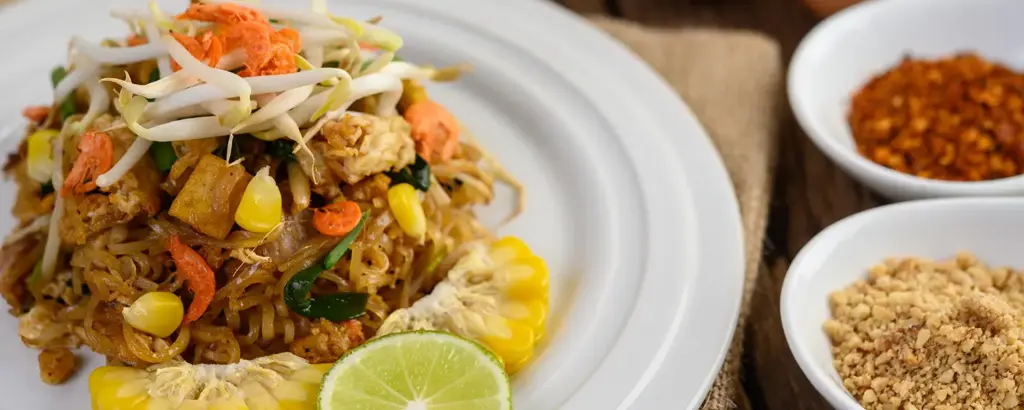Pad Thai – A Culinary Icon of Thailand
Pad Thai, a dish synonymous with Thai cuisine, is celebrated worldwide for its complex yet harmonious blend of flavors and textures. This quintessential stir-fried noodle dish represents the perfect balance of sweet, sour, salty, and savory flavors, making it a favorite both in Thailand and globally. With its enticing aroma, vibrant colors, and tantalizing taste, Pad Thai has become a symbol of Thailand’s culinary excellence.
In this article, we will explore the origins of Pad Thai, its essential ingredients, preparation methods, variations, and its significance in Thai culture and cuisine.

The Origins of Pad Thai
Although Pad Thai feels like an ancient recipe, its history dates back to the mid-20th century. The dish was popularized during the 1930s and 1940s under the leadership of Prime Minister Plaek Phibunsongkhram, who sought to foster a sense of national unity and identity through food. At the time, Thailand (then known as Siam) was undergoing modernization and seeking to distinguish itself from neighboring countries.
In an effort to promote nationalism and reduce rice consumption, which was one of the country’s key exports, the government encouraged the consumption of rice noodles. Pad Thai, made from stir-fried rice noodles, was born out of this initiative. It became a national dish, promoted for its use of local ingredients and its appeal to all social classes. Its popularity quickly spread, making it an integral part of Thai cuisine.
Interestingly, Pad Thai reflects the influences of other Asian cuisines, particularly Chinese. The technique of stir-frying noodles is believed to have been borrowed from Chinese immigrants in Thailand, who introduced the concept of wok-cooked dishes. Over time, the dish was adapted to include uniquely Thai ingredients and flavors, resulting in the version we know and love today.
Essential Ingredients in Pad Thai
Pad Thai is known for its careful balance of flavors, achieved through a combination of key ingredients that reflect the core principles of Thai cooking. Each element in the dish contributes to its distinctive taste and texture:
- Rice Noodles: The foundation of Pad Thai is flat, thin rice noodles. These noodles are soft, yet firm enough to hold up to stir-frying without becoming mushy. They absorb the flavors of the sauce while maintaining a pleasant chewiness, making them the perfect vehicle for the dish’s bold flavors.
- Proteins: Pad Thai can be made with a variety of proteins, with the most common options being shrimp, chicken, tofu, or pork. Shrimp Pad Thai is one of the most traditional and widely loved variations, but vegetarian versions using tofu are also popular. The proteins are typically stir-fried with the noodles, allowing them to take on the flavors of the dish.
- Tamarind Paste: The heart of Pad Thai’s tangy and slightly sour flavor comes from tamarind paste, which is made from the pulp of tamarind fruit. Tamarind is a crucial ingredient in Thai cuisine, adding depth and complexity to the dish’s sauce.
- Fish Sauce: Fish sauce is essential for the umami and salty elements of Pad Thai. Made from fermented fish, this pungent condiment is a staple in Thai cooking, lending its rich, savory flavor to many dishes.
- Palm Sugar: For sweetness, palm sugar is used in the Pad Thai sauce. Derived from the sap of palm trees, palm sugar has a caramel-like sweetness that adds balance to the dish’s sour, salty, and savory notes.
- Eggs: Eggs are scrambled and stir-fried with the noodles, adding richness and a slight creaminess to the overall texture.
- Peanuts: Crushed peanuts provide a crunchy contrast to the soft noodles and add a nutty flavor to the dish. They are typically sprinkled on top of the finished dish as a garnish.
- Bean Sprouts and Green Onions: Bean sprouts and green onions (scallions) add freshness and texture. The raw bean sprouts offer a crisp bite that contrasts with the soft noodles, while green onions provide a mild, aromatic flavor.
- Lime: A wedge of lime is often served alongside Pad Thai, allowing diners to squeeze fresh lime juice over the dish to enhance its bright, tangy flavor.
- Dried Chili Flakes: For those who enjoy a bit of heat, dried chili flakes are usually served as a condiment, allowing each person to adjust the spiciness of their Pad Thai to their liking.
How Pad Thai is Prepared
The preparation of Pad Thai requires a balance of heat, timing, and technique. Traditionally cooked in a wok, this method allows for quick, high-heat cooking, which is essential for achieving the desired texture and flavor. Here is a step-by-step breakdown of how Pad Thai is typically prepared:
- Soaking the Noodles: The rice noodles are soaked in water to soften them before stir-frying. They should be pliable but not fully cooked at this stage, as they will finish cooking in the wok with the other ingredients.
- Making the Sauce: The Pad Thai sauce is a blend of tamarind paste, fish sauce, and palm sugar, mixed together until the sugar dissolves. This sauce provides the essential flavor base for the dish, combining sweet, sour, and salty elements.
- Stir-frying the Ingredients: The stir-frying process begins by heating oil in the wok and adding garlic, shallots, or onions for flavor. The protein, whether shrimp, chicken, or tofu, is then added and stir-fried until cooked. The eggs are scrambled in the wok, adding richness to the dish.
- Cooking the Noodles: The softened rice noodles are added to the wok, followed by the Pad Thai sauce. The high heat of the wok allows the noodles to absorb the sauce quickly while maintaining their chewy texture. It’s important to stir-fry the noodles continuously to prevent them from sticking or overcooking.
- Final Touches: Once the noodles are coated in sauce and cooked to perfection, bean sprouts, green onions, and any additional seasonings are tossed in to finish the dish. Crushed peanuts are sprinkled on top, and the dish is served with lime wedges and chili flakes on the side.
Variations of Pad Thai
While traditional Pad Thai is made with shrimp, tofu, or chicken, the dish has many variations that cater to different tastes and dietary preferences. Some popular variations include:
- Pad Thai Goong (Shrimp Pad Thai): One of the most classic versions of the dish, using fresh, succulent shrimp as the primary protein.
- Vegetarian or Vegan Pad Thai: For those following a plant-based diet, Pad Thai can be made with tofu as the main protein and omitting fish sauce in favor of soy sauce or tamari. The rest of the dish remains the same, with rice noodles, tamarind sauce, and vegetables providing the bulk of the flavor.
- Pad Thai with Chicken or Pork: Chicken and pork are also popular protein choices for Pad Thai. These versions offer a meatier flavor and are often more filling.
- Pad Thai Woonsen: This variation substitutes the typical rice noodles with glass noodles (bean thread noodles), giving the dish a slightly different texture but retaining the same iconic flavors.
Pad Thai’s Cultural Significance
Pad Thai is more than just a popular street food dish—it holds deep cultural significance in Thailand. Its creation during the 20th century symbolized a turning point in Thai identity and modernization. The government’s promotion of Pad Thai as a national dish was part of a larger campaign to foster unity and encourage the use of local ingredients. Today, Pad Thai remains a beloved dish that reflects the core values of Thai cuisine: balance, simplicity, and the use of fresh, high-quality ingredients.
In Thailand, Pad Thai is commonly enjoyed as street food, often served from bustling stalls in markets and food courts. The dish’s accessibility and affordability have made it a staple for both locals and tourists. It’s not uncommon to see vendors preparing Pad Thai right in front of customers, using high heat and quick cooking techniques to produce a fresh and flavorful dish.
Despite its humble origins, Pad Thai has achieved international fame, and it can now be found on menus in Thai restaurants around the world. Its versatility, accessibility, and satisfying flavor profile have made it a global favorite.
Conclusion: The Global Appeal of Pad Thai
Pad Thai’s global popularity is a testament to the power of simplicity, flavor, and tradition. Its unique blend of sweet, sour, salty, and savory elements, combined with the comforting texture of stir-fried noodles, makes it a universally appealing dish. Whether enjoyed from a street vendor in Bangkok or a high-end restaurant in another part of the world, Pad Thai captures the essence of Thai cuisine in every bite.
For travelers to Thailand, Pad Thai is often one of the first dishes they try, offering a delicious introduction to the country’s rich culinary traditions. It serves as a reminder of how food can unite people across different cultures, with its irresistible taste transcending borders and bringing people together.
In the world of Thai cuisine, Pad Thai is a dish that stands as both a symbol of national pride and an ambassador of flavor, forever etched in the hearts of those who have tasted its magic.









